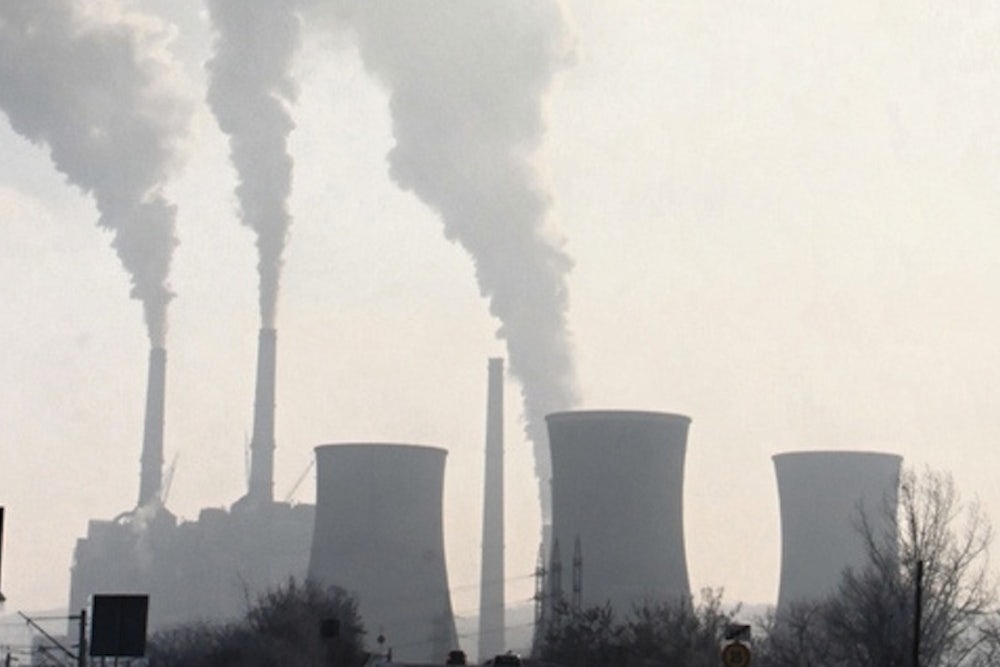“Here are my words for the EPA,” a speaker at a Sierra Club event, Laura MacLeery, shouted into a mic in a packed room Thursday morning. “Be bold, brave, creative, visionary! Carpe diem!” She was rallying a troop of volunteers from green groups like the League of Conservation Voters and the National Wildlife Federation to walk the few blocks to the Environmental Protection Agency’s Washington, D.C., headquarters, where the public had been invited to weigh in on proposed standards for carbon pollution.
This week marks the end of the EPA’s 11-stop tour to collect input for a rule that will govern carbon emissions at existing power plants, which will be released in draft form in June. The carbon standards will be the first of their kind, and ever since President Obama proposed a version of them in 2012, the energy industry—especially coal, the fuel with the highest carbon output—has loudly proclaimed itself under siege. But the environmental activists who filled most of the seats at the D.C. listening session seemed every bit as nervous as their opponents, and their fear that the agency won’t go far enough is justified. “I’m asking the EPA today to act with real political gumption,” said MacLeery. “To look past the industry’s predictable objections and the easy compromises that could weaken a standard.”
Despite his ambitious climate agenda, Obama has proved relatively friendly to the fossil fuels industry: He may yet approve the controversial Keystone XL pipeline, and his standards for new power sources, which came out in September, disappointed environmentalists by capping natural gas emissions at a level that plants are already meeting instead of pushing for new, cleaner technology. But with few coal-fired plants being built these days for economic reasons, the new plant rules never stood to make as much difference as the forthcoming standards for existing plants, which could clamp down on the dirtiest polluters. A December 2012 proposal from the environmental think tank Natural Resources Defense Council provides some glimpse of what the rule could accomplish. As New York’s Jonathan Chait wrote recently, the plan “would reduce U.S. [greenhouse gas] emissions by 10 percent per year… Of course, it’s far from clear Obama will settle on a regulatory proposal as aggressive as the NRDC’s.”
The hearings at the EPA’s regional offices this month produced plenty of testimony meant to curb the agency’s eagerness for reform. The western magazine High Country News reported that Peabody Coal bused supporters from rural Colorado to the Denver session on October 30, and the people they assembled “seemed to carry the day.” In D.C., the only people who testified against regulation were trade group and utility representatives, and the pro-regulation speakers outnumbered them as much as two to one. The audience was dotted with robin’s egg blue “Climate Action Now!” tee-shirts, and red shirts for “Moms Clean Air Force” (“fighting pollution with mother love”). The most memorable mom was actually a dad named Tom Lalley, who brought his one-year-old daughter up with him and struggled to hold onto her as she reached in fascination for the microphone. “I’m here today because of Jane, because her generation will be greatly affected by climate change,” he said.
Some of the testimony was erudite. Howard University School of Law professor and Sierra Club program director Leslie Fields spoke about climate change and pollution’s devastating impact on communities of color. “African American children have the highest rates of asthma attacks of all ethnic groups and African Americans age five to 34 are five times more likely to die of asthma than caucasians,” she recited. Some of the testimony was spiritual. Christians, Jews, Baha'is, Unitarian Universalists, and Muslims signed up to participate. “As a Christian, I am called to love, serve, and protect what Jesus loves, serves, and protects,” said Elizabeth Stevens of Interfaith Power and Light. “Climate change is evidence of our failure.” One testimonial was delivered from beneath a towering, sparkling crown, by Miss Teen Essence of Virginia, Niasia Ellis, who said she volunteers with the American Lung Association.
Outside the EPA’s front door, the trade group American Coalition for Clean Coal Electricity parked a mobile billboard that read, “Tell EPA, Coal = Jobs + Affordable Electricity,” and its spokeswoman groused that none of the listening sessions had been scheduled in states that get the biggest proportion of their energy from coal, and that the EPA was shutting out “the millions of Americans who stand to lose the most.” She’s not the first to make that accusation: In early October, Senate Minority Leader Mitch McConnell sent the agency a letter that said, “it appears as though the EPA has intentionally made it virtually impossible to hear from those who live in Kentucky coal country.” The claim of intention is false, since the meetings were simply held at the EPA’s pre-existing regional offices. So, to some extent, is the claim of exclusion, since the EPA’s offices encompass three of the top ten coal producing states (Pennsylvania, Texas, and Illinois; and Colorado is eleventh), which also happen to be three of the states that produce the most energy from coal, according to the Energy Information Administration.
As many attendees at the listening session were eager to show, the industry’s claim that coal states stand to lose the most may be off-base, too, at least in the long-term. One women who testified said she felt incapable, as a parent, of preparing her young daughter to live on what could soon be a severely different planet. “I’d love some help on that,” she addressed to the room, “if anyone has any ideas."
